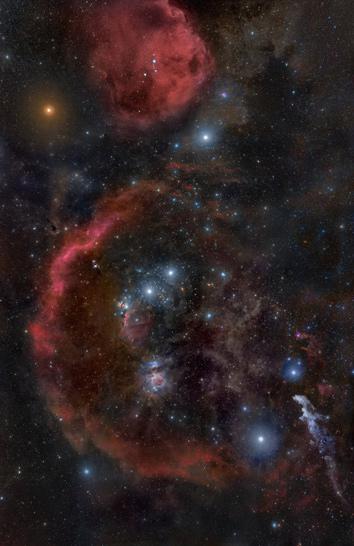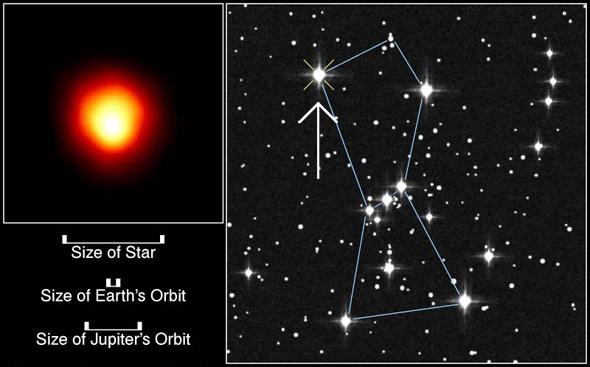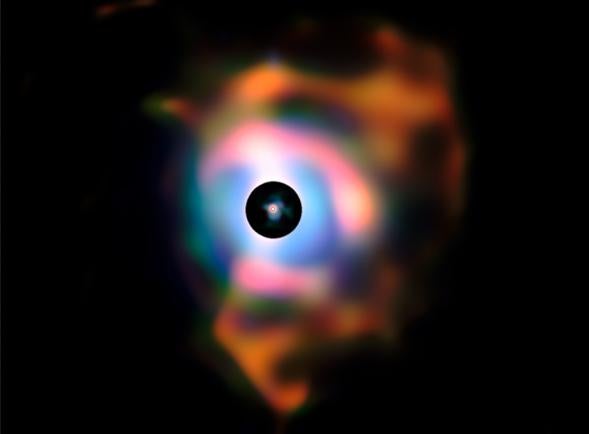If there’s one star in the sky people know about, it’s Betelgeuse.*
Marking the right shoulder of the hunter Orion—remember, he’s facing us, so it’s on our left—this orange-red star is one of the brightest in the night sky. It’s been studied for as long as we’ve had telescopes, yet for all our advanced technology and knowhow, details about it are maddeningly vague. We don’t even have a good determination of how far away it is!
Still, there’s a lot we do know: It’s a red supergiant, a star that started out life already a lot bigger, more massive, and far more luminous than the Sun. Stars like that go through their nuclear fuel extremely rapidly; while the Sun is only approaching middle age at 4.5 billion years old, Betelgeuse is dying now at an age of less than 10 million years old. And when it does finally give up the ghost, it’ll do so with a bang. A very, very big bang: It’ll go supernova, one of nature’s most dramatic and ridiculously violent events.
But when? A lot’s been written about that. If you believe pseudoscientists and crackpots, you might have thought 2012 was our last chance to see it. Sometimes the news spreads that it’ll go any day now. Somehow, oddly, despite all that nonsense you can still see Betelgeuse shining in the sky.

Photo by Rogelio Bernal Andreo, used by permission
However, the thing is, it really will explode one day. We don’t really know when, exactly, which is why I usually hedge my bet by saying it could be tonight, but more likely it’ll be hundreds of thousands of years from now … a million years, tops.
As a scientist, that date range is a little bothersome. That’s why I was delighted to read a research paper trying to nail down this very fact. While it’s still a bit iffy, and details are still elusive, the astronomers who did the research were able to make a much more refined prediction: Betelgeuse will go boom in about 100,000 years.
Wow. That’s sooner than I would have thought. It’s still a long way off, of course, but in a galactic sense that’s a blink of the eye.
This prediction depends on a lot of things, so the astronomers had to determine many basic facts about the star as best they could (generally depending on the previous work of others). It’s all pretty amazing, so let me list them out for you with brief comments:
Distance: Betelgeuse is likely to be about 200 parsecs (650 light years) away. Different methods yield different distances, which has been frustrating, but a recent paper gives what may be this best result.
Age: Models of the star’s evolution over time yield an age estimate of about 8.5 million years. That’s a bit older than I would have expected, but quite reasonable. Compare that with the Sun’s age of 4.56 billion years, and you’ll see why I say stars like Betelgeuse don’t live long!
Mass: The best estimates of the mass of Betelgeuse give about 20 times that of the Sun (more or less). That’s a lot; as you get more massive, stars get more rare, and only a handful get this hefty.

Photo by Andrea Dupree (Harvard-Smithsonian CfA), Ronald Gilliland (STScI), NASA and ESA
Radius: This is where we start getting into “yikes” territory: Betelgeuse is a staggering 890 (± 200) times wider than the Sun! Bear in mind the Sun is more than 100 times wider than the Earth and you may realize what a behemoth this star is. That’s a radius—a radius—of more than 600 million kilometers! Replace the Sun with Betelgeuse, and it would stretch nearly to the orbit of Jupiter. The Earth would be engulfed.
Rotation: Stars tend to rotate slowly. When they expand, as Betelgeuse did long ago, they slow down. (This is called conservation of angular momentum, like when an ice skater draws in his or her arms and spins more rapidly.) Betelgeuse is huge, so unsurprisingly it spins very slowly, only once every 8.4 years. The Sun spins about once a month, for comparison.
Luminosity: Betelgeuse is bright. It shines with the energy of 125,000 times that of the Sun. Holy wow. That’s why it can be hundreds of light years away and still be one of the brightest stars in the sky. At that distance, you’d need a telescope to see the Sun at all.
Mass loss: When massive stars use up the hydrogen fuel in their core, they start to fuse helium into carbon. This generates a lot of heat, which causes the outer parts of the star to expand (hot gases expand, after all). Betelgeuse is pretty bloated, which means gravity at its surface is pretty weak. The star is also incredibly luminous, so a gas molecule on its surface feels a strong outward force from the light, and only a weak force from gravity holding it down. The result: Betelgeuse blows a very strong wind of material away from it. It loses about a millionth of the mass of the Sun every year. That may not sound like much, but the Sun loses less than a trillionth of its mass every year. Betelgeuse blasts out a million times as much material as the Sun. That’s not a solar wind. It’s a gale.

Photo by ESO/P. Kervella
The supernova: Using all these data, plus what we know about how stars evolve over time, the astronomers find that in about 100,000 years, Betelgeuse will run out of helium to fuse. The steps after that are a bit complicated, but essentially, it will begin to fuse ever-heavier elements on ever-shortening timescales, until it tries to fuse silicon into iron. This spells doom for the star, because it robs the star of the energy needed to support itself. The core collapses, heats up beyond imagining, and explodes. KaBLAM! No more Betelgeuse.
The aftermath: First, repeat after me: WE ARE IN NO DANGER, EVER, FROM BETELGEUSE.
At that distance, even the titanic detonation of a supergiant star poses no major threat. It’ll be bright, as bright as the full Moon! But it’s too far away to hurt us. Also? 100,000 years is a long time.
Mind you, it’ll launch octillions of tons of matter into space in all directions at a decent fraction of the speed of light. But as it plows through the thin soup of stuff in space it’ll slow down. The astronomers in the paper estimate the shock wave will take 6 million years to reach us and will be moving at a mere 13 kilometers per second. It’ll slam into the Sun’s outgoing solar wind, and the two will wrestle, but the shock itself will stop well outside the Earth’s orbit.
We’re safe.
But holy cow, that’ll be a show. But you’ll have to wait a hundred millennia for the opening curtain.
I’m not that patient. Statistically speaking, a galaxy hosts a supernova every century or so. The Milky Way hasn’t had one pop off for a long time, so we’re bound to get one sooner or later that we can study. We may get a thousand or so before Betelgeuse finally loses it. Some will almost certainly even be closer than Betelgeuse is. Again, we’re in no real danger from a nearby supernova, and it would be nice to see one at a relatively proximate distance. Oh, what we’d learn!
… but poor Orion. Once Betelgeuse goes, and fades away over a few months, he’ll be missing his right shoulder. I wonder what myths we’ll have to modify to accommodate for that?
Tip o’ the neutrino detector to Tod Lauer.
Related Posts:
What Is the Nearest Star to Earth That Can Go Supernova?
(But bear in mind: The Closest Supernova Candidate?)
Betelgeuse Blows Out a Monstrous Arc of Gas Nearly As Big As Our Solar System
Betelgeuse Is About to Hit the Wall
Is Betelgeuse About to Blow?
Betelgeuse and 2012
*OK, fine, a lot of people know Polaris, too. And I guess, if you want to be picky, they’ve heard of the Sun as well. But still. Betelgeuse!
